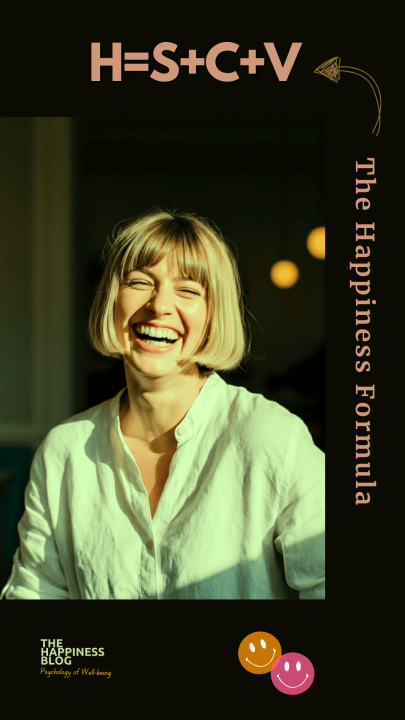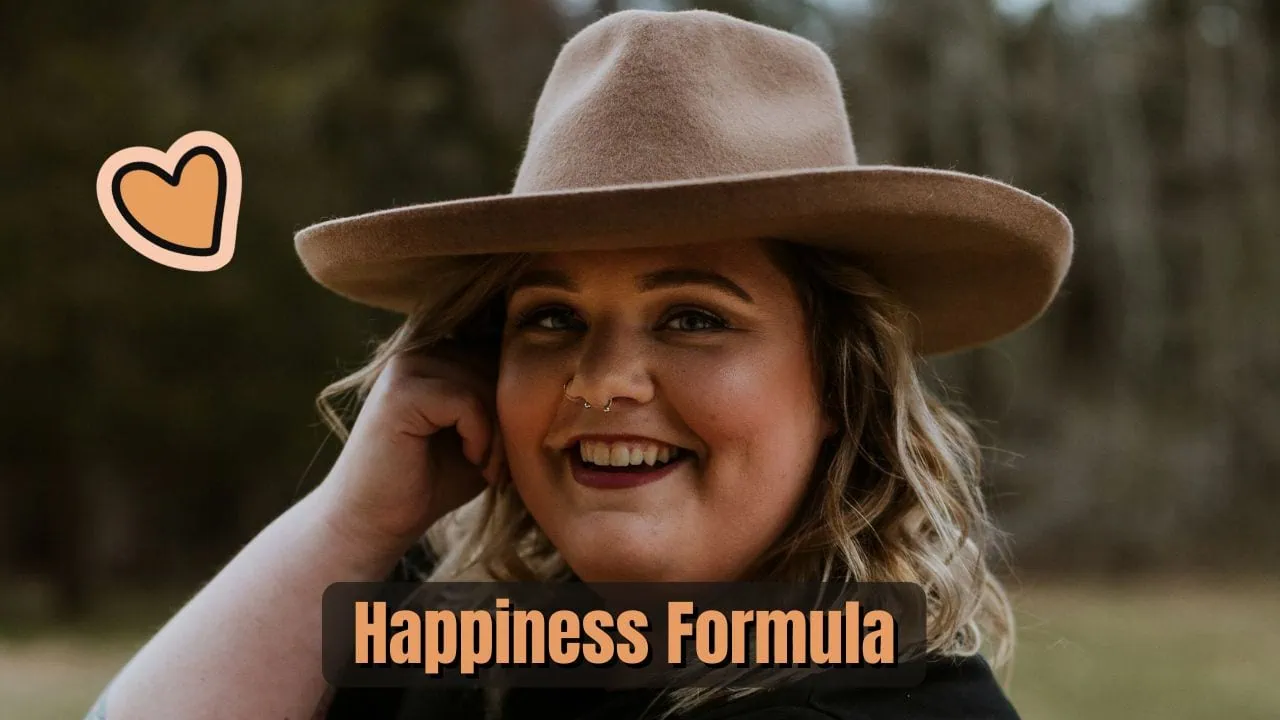Today's Tuesday • 15 mins read
The world’s first authentic happiness formula, H=S+C+V, says that our overall happiness (H) is the sum of three key factors: happiness set point (S), life circumstances (C), and voluntary activities (V). Which factor should we focus on to get the most happiness?
In the 20th century, psychology primarily focused on pathology, victimology, and mental illness (like narcissism). For every one hundred published articles on mental illness, there was only one published on mental health.
As a result, humanity gained a great understanding of the negative aspects of human behavior, such as depression, anxiety, and schizophrenia.
Unfortunately, it also led to only very little progress on positive aspects of human behavior, such as happiness and well-being.
The psychologists were pretty good at taking someone from -8 to -4 to 0 on a scale of well-being. But they weren’t very skilled at getting someone from 0 to +4 to +8.
In 2000, Seligman and his colleagues started aggressively studying the positive elements of human living, such as positive emotions, emotional resilience, and what makes people happy. They forged a new branch of research called Positive Psychology.
Two years later, in 2002, Martin Seligman published a book on happiness called Authentic Happiness. The book distills years of research into practical and easy-to-understand guidelines for living a happier life. Right at the heart of the book lies his formula for happiness—a super simple overview of all the factors that influence our happiness.
In this article, we take a thorough look at the formula and find out what you could do to become happier.
However, we must remember that mental illness remains a major concern even today, and we cannot dismiss it at the expense of pursuing happiness.
Today, nearly 1 billion people live with a mental disorder and in low-income countries, more than 75% of people with the disorder do not receive treatment. Every 40 seconds, a person dies by suicide. About 50% of mental health disorders start by the age of 14.
— Rialda Kovacevic, MD MPH, World Bank, 2021
The Happiness Formula
Seligman gave the world its first authentic formula for happiness: H=S+C+V, where (H) stands for happiness. Happiness is the sum of three factors: one’s genetic happiness set range (S), factors under one’s voluntary control (V), and life circumstances (C). S constitutes 50%, V takes up 40%, and C sums up to only 10%.
H=S+C+V
- H stands for your enduring level of happiness.
- S is your set range or set point.
- C is the circumstances in your life.
- V represents factors under your voluntary control.

Let’s find out more on each factor and how best to optimize them to maximize your happiness.
H: Your Enduring Level of Happiness
It’s important to distinguish between your momentary level of happiness and your enduring level of happiness.
Little events of joy, like praise from your boss, chocolate, a fun movie, acts of love, a promotion at your job, or a weekend spa treatment, can easily increase momentary happiness.
Increasing the number of transient bursts of happiness in your life, however, is not the goal here. Instead, the goal is to raise your enduring level of happiness (which you will not accomplish by merely increasing the number of bursts of momentary positive feelings).
The remaining three variables in the happiness formula will show us what increases or decreases our enduring levels of happiness.
S: Your Set Range
Some discouraging news: About 50 percent of your happiness is completely out of your control because it depends on your genes.
You may be genetically wired to be more-than-average happy most of the time. Or you may be wired to be sullen and dour most of the time. Or you’re somewhere in the middle.
The point is that our genes make up 50% of our happiness, and we can’t change much of that. This means you have a so-called happiness set-point towards which you will always gravitate, whether in your good times or in bad times.
Going on holiday (find out how traveling makes you happier), meeting your future spouse, or bagging that promotion you have been waiting for will raise your happiness levels. However, it is only for a while, and in a few weeks or months, you will drift back to your happiness set point.
This happens because of a process called adaptation (or hedonic adaptation).
Human beings, it turns out, are adaptation machines. We take good things for granted and overcome daunting obstacles, only to return to our natural happiness set-point.
- Did you win the lottery? You’ll be happier for a few months, but then you’ll be back to your set point.
- Did you get fired from your job? You’ll be less happy for a few weeks or months, but then you’ll be back at your set point.

Here’s an example from the book Authentic Happiness:
Even individuals who become paraplegic as a result of spinal cord accidents quickly begin to adapt to their greatly limited capacities, and within eight weeks they report more net positive emoting than negative emotion. Within a few years, they wind up only slightly less happy on average than individuals who are not paralyzed.
The bottom line is, that we have a set range of happiness towards which we naturally gravitate. This set range is what’s keeping your level of happiness from increasing.
Thankfully, we can use the other remaining variables, C and V, to raise that level. But there’s a catch there. Read on to find out.

C: Circumstances
If you want to raise your level of long-term happiness by changing the external circumstances of your life, Martin Seligman says, the following strategies work:
- Live in a wealthy democracy, not in an impoverished dictatorship (a strong effect)
- Get married (a robust effect, but perhaps not causal)
- Acquire a rich social network (a robust effect, but perhaps not causal)
- Avoid negative events and negative emotions (only a moderate effect)
- Get religious (which has a moderate effect, though)
And here are the external circumstances that you do not need to bother too much about:
- Make more money (money has little or no effect once you are comfortable enough; more materialistic people are less happy)
- Stay healthy (subjective health, not objective health, matters)
- Get as much education as possible (no effect)
- Change your color or move to a sunnier climate (no effect)
You’ve probably noticed: Changing any of these circumstances is impractical, expensive, or downright impossible.
And even if you could modify all the above circumstances, they wouldn’t make much of a difference to your happiness.
Why? Because they account for only between 8 and 15 percent of the variance in happiness.
The good news is that there is a set of internal circumstances that are easier to change and will have a greater impact on your happiness. These internal circumstances are what the last variable, V, is all about.
V: Voluntary Variables
This is the best and most controllable part of the happiness formula.
If you want to change your enduring level of happiness, this is where you must put your money.
The Voluntary Variables account for about 40 percent of your happiness and are divided into three buckets:
- Positive emotions about the past (e.g., satisfaction, contentment, fulfillment, pride, and serenity)
- Positive emotions about the future (e.g., optimism, hope, faith, and trust)
- Positive emotions about the present (e.g., joy, ecstasy, calm, ebullience, pleasure, and flow)
The more positive emotions you have about the past, future, and present, the happier you will be.
Therefore, to raise your lasting level of happiness, change how you feel about your past, how you think about the future, and how you experience the present.
We’ll take a closer look at each of those right now.

How to Feel Lastingly Happier About Your Past
How you feel about the past can have a big impact on your happiness. You can either experience plenty of negative emotions about the past (such as resentment, anger, and pity) or positive emotions (such as satisfaction, contentment, fulfillment, pride, and serenity).
The more positive your view of the past is, the happier you will be. That may sound a bit oversimplified, but it’s mostly true.
So, how do you improve your happiness about the past?
Three strategies to help you feel happier despite your past:
- Let go of the belief that your past determines your future. Thinking that your past determines your future makes you more passive about life. The remedy may be simple: Remind yourself that you have a fairly large amount of control over life. You can make yourself happier. You can become more successful. And, you can achieve many great things if you put in the work and stay patient.
- Be grateful for the good things in your life. Gratitude amplifies the pleasant events in your life. Build an attitude of gratitude — write a gratitude letter, do gratitude journaling, or practice the Three Good Things (TGT).
- Learn to forgive past wrongs. Forgiveness is about letting go of the bitterness of traumatic events and terrible memories. Forgiving doesn’t mean condoning the offense or the offender. It means releasing the hold on your grudges, anger, resentment, and pity.
Everett Worthington recommends a process called R.E.A.C.H. to practice forgiveness. REACH is an acronym for:
- Recall the hurt.
- Empathize or, more broadly, emotionally replace negative emotion with positive emotion. So replace the negative emotion with empathy or compassion or love or sympathy for the person.
- Altruistic giving of forgiveness. This is not a self-interested gift, it’s not a self-enhancing gift. It’s something to bless the other person.
- Commit to the forgiveness experience.
- Hold on to the forgiveness experience.
Next up, how to feel better about your future.
How To Feel Lastingly Happier About Your Future
Your feelings about the future — whether good (optimism, hope, faith, and trust) or bad (fear, anxiety, or dread) — are determined in large by your thoughts and interpretations of the world.
If you think you’re going to mess up your next week’s presentation completely, then you won’t be happy. If, on the other hand, you’re eagerly awaiting your vacation in Bali next month, then you’ll be a lot happier.
The #1 strategy Seligman recommends for improving our feelings about the future is to recognize and dispute automatic pessimistic thoughts. It’s all about keeping things in perspective, and it’s pretty easy to do.
To improve how you feel about the future, recognize and dispute your automatic pessimistic thoughts.
Let’s say you’ve just got some bad feedback from your boss. Your natural reaction might be terribly negative:
“Oh my God, I must be the worst employee ever. I can’t even get a simple reservation right. Maybe I should just quit. My boss thinks I’m useless anyway. I really can’t seem to do anything right. I’m such a loser …”
Instead of letting such negative thoughts make you unhappy, why not dispute them?
Like this example:
“Okay, so my boss wasn’t happy with my performance. That’s OK. I guess I really could have put in more effort. I was slacking a bit. Let me work a lot harder over the next few weeks to show my boss what I’m capable of. I want to be better than what I’ve shown lately. I’m really excited about that. Let’s make it happen!”
That’s how you can go on from sadness, despair, and self-pity to excitement and optimism by disputing automatic negative thoughts.
You can be a lot happier if you drew the second interpretation of the incident after challenging the first that came up automatically.
By the way, there are differences between hope and optimism.
How to Feel Lastingly Happier In The Present
Alright, improving how you’re feeling about the present is the last step in lastingly raising your enduring level of happiness.
To feel lastingly happier in the present, we need to understand the difference between pleasure and gratification.
Pleasures
These are delights that have clear sensory and strong emotional components, what philosophers sometimes call “raw feelings”: exuberance, thrills, ecstasy, orgasm, mirth, delight, and comfort.
They are mostly temporary and involve little, if any, thinking.
Examples of pleasureful activities include watching TV, getting a massage, listening to music, eating chocolate, or drinking some wine.
[You shouldn’t always give pleasure a top priority. Find out why: You Must Ask For Joy, Not Pleasure.]
Gratifications
These activities aren’t necessarily accompanied by any raw feelings at all. Rather, the gratifications engage us fully so that we become immersed and absorbed in them, and lose self-consciousness.
In other words, we experience flow. Time stops, our skills match the challenge, and we are in touch with our strengths.
The gratifications last longer than the pleasures, involve quite a lot of thinking, and are secured by our virtues and strengths.
Examples of gratifications are playing volleyball, enjoying a great conversation, rock climbing, reading a delightful book, dancing, or helping the homeless.
The key to living a truly happy life is to increase the amount of gratification you experience in your own life.
Pleasures are fine and can make you temporarily happy, but they will never bring you lasting and fulfilling happiness. In fact, the average state of someone watching TV is mildly depressed.
Put differently, to live a happy life, stop chasing momentary pleasures, and start experiencing more flow instead.
How do you increase the gratifications in your life?
For one, don’t be a couch potato. Go out there and do something, like engaging in sports and finding a hobby.
Ask yourself, when does time stop (the “flow” state) for you? When do you find yourself doing exactly what you want to be doing and never wanting it to end?
Positive Psychology has categorized a set of 24 character strengths, and we each have aspects of these strengths in our personality. Of these, our “signature strengths” are those character strengths that are essential to who we are.
When you figure out what are your signature character strengths and use them as often as possible, you can increase your happiness and life satisfaction.
Happiness science suggests that the more we use our signature strengths, the more happiness and well-being we experience.
Using our top character strengths in the main areas of our life can help us experience authentic happiness more often. Martin Seligman puts it this way:
The good life is using your signature strengths every day to produce authentic happiness and abundant gratification.
— Martin Seligman
Below are Dr. Roy’s top five character strengths:
- Appreciation of Beauty and Excellence: Finds beauty in nature, art, science, ideas, people, and everyday experience.
- Honesty: Speaks the truth almost all the time, and acts and presents himself genuinely.
- Love of Learning: Tries to learn something from every situation, and loves mastering new skills.
- Judgment: Examines, thinks, and analyzes the details of an issue from all sides.
- Perspective: Can provide wise counsel to others, and look at the world in ways that make sense to themselves and others.
Studies on character strengths:
- Highlighting strengths in response to discrimination — Warren & Sekhon (2022)
- The role of signature strengths in treatment outcome — Uliaszek & Rashid (2021)
- Why are signature strengths and well-being related? — Blanchard & Kerbeykian (2019)
- Is awareness of strengths intervention sufficient to cultivate wellbeing? — Dolev-Amit (2020).
Final Words
Let’s go over a quick recap of what we learned today. We’ve looked at the happiness formula:
H=S+C+V
It states that your enduring level of happiness (H) equals your set range (S) + the circumstances in your life (C) + factors under your voluntary control (V).
- Your set range (S) makes up about 50% of your happiness. Your genes determine that portion. This means you always roll back towards your natural set point of happiness, whether from a state of great happiness or great sadness.
- Unless the other two variables change, your overall happiness will not change much throughout your lifetime.
- Your external circumstances (C) make up only about 10% of your happiness. Some proven strategies to optimize your circumstances for happiness include living in a wealthy democracy, getting married, avoiding negative events and emotions, acquiring a rich social network, and becoming religious. Maximizing these circumstances is usually expensive, hard, and not very practical.
- The money lies in improving factors under your voluntary control (V), which makes up around 40% of your overall happiness. These factors include increasing positive emotions about the past, the future, and the present.
And there you have it. That is the science of happiness in a nutshell.

FAQs
What is the formula for happiness?
How much happiness comes from our genes?
1. Professor Martin Seligman’s research suggests that wellbeing and life satisfaction, closely connected to happiness, are between 30% and 40% heritable.
2. Psychotherapist Susan Zinn suggests that wellbeing and life satisfaction, closely connected to happiness, are between 30% and 40% heritable. This suggests that our genes make up an estimated 40% of our ability to be happy.
3. However, Zinn also notes that it’s possible to rewire our brains for happiness, and the other 60% of happiness comes down to lifestyle and other environmental factors.
• • •
√ Also Read: Does money make you happier: What does the research say
• • •
Author: Nils Salzgeber, a lifestyle coach and co-founder of NJlifehacks, a blog dedicated to helping people live a better life through relentless self-improvement. Nils is on his journey to becoming the greatest version of himself and loves sharing what he learns along the way.
Editor: Reviewed and edited by Sandip Roy – medical doctor, psychology writer, happiness researcher.
√ If you liked it, please spread the word.
» You deserve happiness! Choosing therapy could be your best decision.
...
• Disclosure: Buying via our links earns us a small commission.
